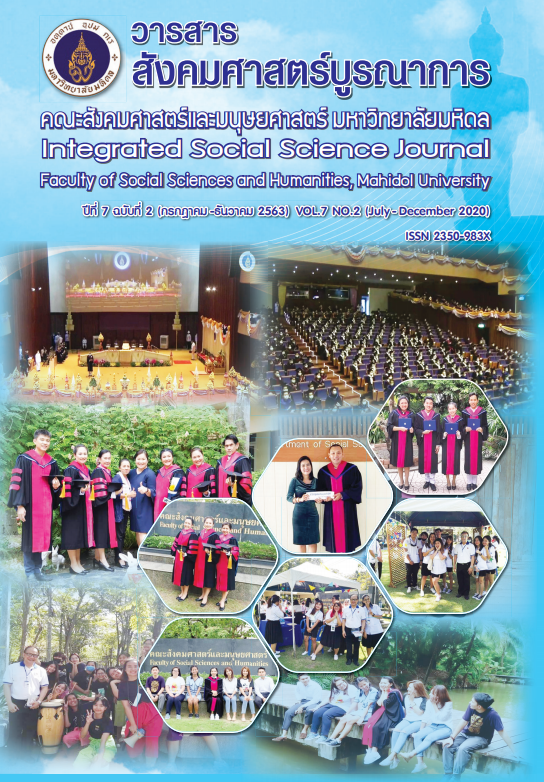Participation of Mahidol University Students in Solid Waste Management: A Case Study of Salaya Campus Nakhon Pathom Province
Main Article Content
บทคัดย่อ
This research aimed to study the participation of Mahidol University students in solid waste management. Factors influencing students’ participation in solid ware management were investigated. The problems, barriers, and suggestions towards participation in solid waste management were also explored. Quantitative research method was employed. The target population included 400 bachelor students in Mahidol University. Questionnaire survey was applied as a tool to collect data. The data was analyzed by using multiple regression, mean, and standard deviation.
Most of the respondents were female (65.5%) and 19 years old (63.3%). Some 64.2 percent of the respondents were from Nonthaburi, Nakhon Pathom, Chonburi, Samutprakarn, and Nakhon Ratchasima Province. Most of the respondents was Buddhist (98.8%) and was studying Sciences and Engineering (45.3%). The study result found that the knowledge of respondents regarding solid waste management was moderate (59.3%). The level of participation in solid waste management was moderate (63.6%). The factors significantly related to participation in solid waste management included sex (p-value = 0.05) and knowledge (p-value = 0.01).
This research recommended to conduct future study by surveying the areas of solid waste problems in order to place waste containers in those areas. Separate waste containers should be provided in the buildings and over the university. Since the knowledge of solid waste management was moderate, the training on solid waste management and biodegradable transformation process should be offered to the students. The awareness towards solid waste should be raised. The information on solid waste management should be disseminated via info graphic poster. The content in info graphic should be easy to understand in order to enhance effective solid waste management in Mahidol University, Salaya Campus, Nakhon Pathom Province.
Article Details
- วารสารสังคมศาสตร์บูรณาการ มหาวิทยาลัยมหิดล อนุญาตให้สามารถนำไฟล์บทความไปใช้ประโยชน์และเผยแพร่ต่อได้ โดยอยู่ภายใต้เงื่อนไขสัญญาอนุญาต CC Attribution-NonCommercial-NoDerivatives 4.0 International (CC BY-NC-ND 4.0) โดยต้องแสดงที่มา/การอ้างอิงจากวารสาร – ไม่ใช้เพื่อการค้า – ห้ามแก้ไขดัดแปลงเนื้อหา
- ข้อความที่ปรากฏในบทความในวารสารฯ เป็นความคิดเห็นส่วนตัวของผู้เขียนแต่ละท่าน ไม่เกี่ยวข้องกับกองบรรณาธิการวารสารฯ (ซึ่งหมายรวมถึง บรรณาธิการ ผู้ทรงคุณวุฒิในกองบรรณาธิการ หรือ บรรณาธิการรับเชิญ) แต่อย่างใด ความรับผิดชอบองค์ประกอบทั้งหมดของบทความแต่ละเรื่องเป็นของผู้เขียนแต่ละท่าน หากมีความผิดพลาดใด ๆ ผู้เขียนแต่ละท่านจะรับผิดชอบบทความของตนเอง ตลอดจนความรับผิดชอบด้านเนื้อหาและการตรวจร่างบทความเป็นของผู้เขียน ไม่เกี่ยวข้องกับกองบรรณาธิการวารสารฯ
- กองบรรณาธิการขอสงวนสิทธิ์ในการตัดทอน/ปรับแก้ถ้อยคำบางประการเพื่อความเหมาะสม
เอกสารอ้างอิง
Banya yototha. (2013). Participation in environmental management of community members in Tha Mai Municipality, Tha Mai District, Nonthaburi Province. Faculty of Social and Environmental Development National Institute of Development Administration.
Benjamin, S. Bloom. (1971). Dictionary of Behavioral Sciences. London: Litton Educational Publishing Inc.,
Cherd klangsri. (2014). Participation in waste management of the people of Bang Phut Subdistrict Pak Kret Municipality Nonthaburi Province. Master of Arts Degree Thesis Social Sciences for Development Phranakhon Rajabhat University.
Cohen, John M and Uphoff, Norman T. (1977). Rural Development, Participation: Concepts and Measures for Project Design, Implementation and Evaluation. New York: The Rural Development Committee center for International Studies. Cornell University.
Daryl Morey, Mark Maybury and Bhavani Thuraisingham. (2000). Knowledge Management: Classic and Contemporary Work. Mass.: The MIT Press.
Department of Environmental Quality Promotion. (2007). Hazardous waste and waste. (Online). Available: http:www.environment.in.th/evdb/info/waste/ waste.html
Journal of Environmental Management. (2011). Guidelines for waste management to the center within Mahidol University, Salaya. Year 7, Volume 1, January - June 2011.
Mahidol University (2016). Waste and hazardous waste management policies. Mahidol University: Nakhon Pathom.
Ministry of Education. Office of Policy and Strategy (2015). Official action plan for the fiscal year 2015 of the Ministry of Education. Bangkok: Office of the Permanent Secretary.
National Education Act 1999 B.E. (19 August 1999). Government Gazette. Book 116, Chapter 74, Page 1-28.
Nonaka, kujiro and Takeuchi, Hirotaka. (2000). Classic work: Theory of Organizational Knowledge Creation.
Orathai Kokphon. (2009). Partner Guide to Public Participation for Local Administrators. Bangkok: Charan Sanitwong Printing.
Panphong Kongdechadisak (2014). Public participation in the conservation of natural resources and the environment in the area of Mu Ko Chang National Park, Trat Province. College of Public Administration Burapha University, Chonburi.
Papawarin Na Champa. (2014). Public participation in waste management. Of Khlong Yai Subdistrict Municipality Khlong Yai District, Trat Province. Degree Thesis Master of Public Administration Department of Public and Private Management College of Public Administration Burapha University.
Pollution Control Department. (2018). Operation manual 3 uses (3R) to manage community waste. Bureau of Waste and Hazardous Materials Management Pollution Control Department Ministry of Resources Nature and environment. 2nd edition, Bangkok: Heize Company Limited.
Pollution Control Department. (2018). Guidelines for reduction guidelines and waste separation in government agencies under the project to do good deeds with heart Reduce environmental hazards. Bureau of Waste and Hazardous Materials Management Pollution Control Department Ministry of Resources Nature and environment. Bangkok: Heize Company Limited.
Rattikorn Jongvisal. (2013). Leadership: Research Theory and Ways to Develop. Bangkok: The Publisher of Chulalongkorn University.
Sahasai Inwongwarn. (30 May 2018). Participation in environmental conservation. (Online) Access from https://sahutchaisocialwork.wordpress.com/
Tchobanoglous, G. and Kreith, F. (2002). Handbook of Solid Waste Management (2nd Ed.). New York: McGraw-Hill.
World Health Organization. (1998-2002). Community in Health for Primary Health Care. Paper No. SHS/83-16. Bethesda Md., n.d.


